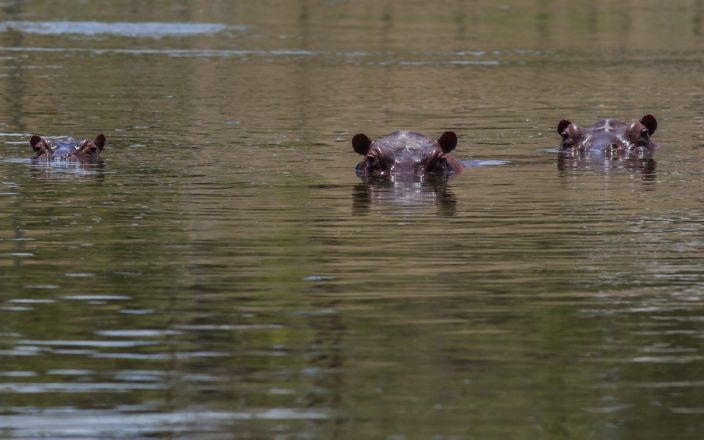Scientists say Colombia must cull its so-called “cocaine hippos” that roam the Magdalena river basin as they are breeding voraciously and are an increasing menace.
The marshlands of Colombia have been home to these giant mammals since they were illegally imported in the late 1980s by the notorious drug lord, Pablo Escobar.
When he was shot dead in 1993, the Colombian government took control of his extravagant estate, including his personal zoo.

Most of the animals were shipped away, but four hippos were left to fend for themselves in a pond, and now there are dozens of them living in the wild.
Although nobody knows exactly how many there are, estimates put the total number between 80 and 100, making them the largest invasive species on the planet.
Scientists forecast that the number of hippos will swell to almost 1,500 by 2040. They conclude, that at that point, environmental impacts will be irreversible and numbers impossible to control.
“Nobody likes the idea of shooting a hippo, but we have to accept that no other strategy is going to work,” ecologist Nataly Castelblanco-Martínez told The Telegraph.

In their natural African habitat, hippos spend the long dry season competing for access to rivers that have shrunk to puddles. They are also vulnerable to disease and predators.
In contrast, scientists say Colombia is a hippo paradise. It rains regularly and there are no problems with food or predators. Researchers believe this optimal environment could have made the hippos more fertile.
Locals see the hippos as an unofficial mascot. Gift shops in the town of Puerto Triunfo sell hippo keychains and T-shirts.
At the amusement park that was built on the site of Escobar’s former mansion, visitors can visit the lake where several dozen hippos now live. But for researchers, these creatures pose an ecological menace, competing with native wildlife and polluting local waterways.
The hippos’ urine and faeces are toxic and the animals also carry a range of dangerous bacteria, which can pose a problem for other species and ultimately humans too.
In Africa, hippos are considered a major threat to the livelihood and security of rural communities. Hippos kill more people annually than any other African mammal.
In Colombia, there are several local anecdotes of hippos chasing people after unexpected encounters. Last year, a Colombian cattle farmer was caught unawares while collecting water. The hippo bit his leg and threw him into the air, breaking his leg, hip and several ribs.

Environmentalists have been trying to sterilise the hippos for years, but it requires much time and effort, and there are few resources available. It can take three months to track an individual animal and the procedure is not easy.
Male hippos have retractable testes and females’ reproductive organs are even harder to find, according to scientists.
“We didn’t understand the female anatomy,” said David Echeverri Lopez, a government environmentalist. “We tried to sterilise females on several occasions and were always unsuccessful.”
He is also playing an impossible game of catch-up. Mr Echeverri told The Telegraph that he is able to castrate roughly a hippo per year, whereas scientists estimate that the population grows by 10 percent annually.
There was public outcry when a hippo was killed in 2009 after it had been terrorising local farmers, but scientists say animal rights campaigners are not considering the whole picture.
“Relocation might have been possible 30 years ago when there were only four hippos,” said Dr. Castelblanco-Martínez. “Castration could also have been effective if officials had provided sufficient resources for the program early on, but a cull is now the only option.”
Mr Echeverri does not agree.
“There has to be another solution. These hippos have become part of the local identity,” he said. “But time is running out.”
Source: Telegraph UK
San Miguel Times
Newsroom
